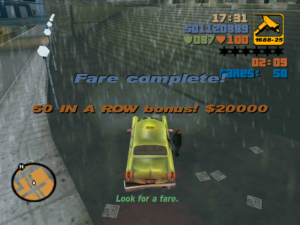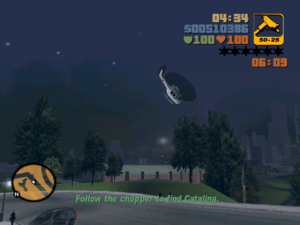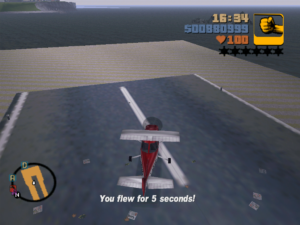Vice City: Controversy and Offense
I’m making progress on the missions again. In one of the multi-stage ones that I haven’t managed to finish yet, I encountered familiar words, flashed on the screen as instructions: “KILL ALL THE HAITIANS!” This, I recalled, was the centerpiece of a Controversy. Certain immigrant advocacy groups had taken exception to the game’s use of Haitian and Cuban gangs, and Rockstar had responded that things had been taken out of context, as if people were seriously misinterpreting “kill all the Haitians” as an exhortation to genocide rather than an instruction to finish the gunfight currently in progress between Haitian and Cuban gang members. The thing is, even if you remove that line, or even that entire mission, there’s still plenty of material that’s insulting or degrading to both Haitians (who, in the game, live in plywood hovels and practice voodoo) and Cubans (who are uniformly obsessed with proving they have “big cojones”). The game is at times a sort of 4chan-ish racism-murder-comedy. As I said about GTA3, “They’re shown to be ridiculous caricatures, and then you kill them.” And this is supposedly after removing the worst of it in response to the complaints.
Part of Rockstar’s defense of and pseudo-apology for their content is that they’re uniformly mean to everyone. Even ignoring how absurd that is as a defense of anything (“But, your honor, I pickpocketed the entire crowd!”), that’s pretty unsatisfying. For one thing, hitting everyone equally just means the most vulnerable are hit the worst. For another, it’s never equal. There are a number of satirical talk radio segments within the game that portray representatives of various social and political movements as buffoonish hypocrites, but that’s hardly the same thing as being told to go kill them. For that matter, the radio personalities aren’t treated all the same. Of all the in-game radio interviews I’ve heard while driving around town, all are satisfied with just letting the subjects make a fool of themselves except one, which takes the extra step of explicitly calling them out, with a paragraph of comment-thread-like abuse from a call-in listener that the interviewee can’t come up with a good response to, giving the author and any like-minded players an opportunity to high-five themselves over the righteous straw-man takedown. See if you can guess what the subject here was. 1Feminism.
Now, I’m no friend of censorship, especially when applied to games. Any concern I have over the content isn’t “Should they be allowed to say this?”, but rather “Are the authors assholes? Is this an asshole game, and by playing it, am I encouraging it?” And I think it’s undeniable that Vice City is written to be an asshole; this was more or less how it was marketed. But I don’t think it’s really significantly more of an asshole than GTA3, and somehow it got a stronger rap for it. The Haitian/Cuban gang war is just the Vice City version of GTA3‘s gang war between the Yakuza and the Colombian cartel — they’re even both instigated by the player character at the behest of a real-estate developer who wants to lower property values — but the mayor of New York didn’t feel compelled to issue a public statement about GTA3 the way he did about Vice City. Perhaps it’s just that the whole thing was less known at that point. By the time Vice City came out, it was already receiving media attention that GTA3 had to earn.
| ↑1 | Feminism. |
|---|
 Comments(0)
Comments(0)

